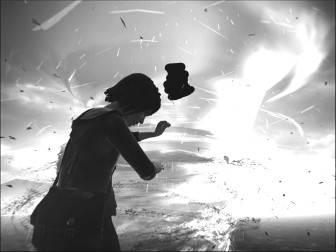
Screenshot from the game

“Life is Strange” is an entertaining, episodic PC game that has themes and plot devices different from other titles like Telltale Games’, “Tales of Monkey Island” or “The Wolf Among Us.”
Excellent graphics and textures befit the game’s autumnal theme. A fitting soundtrack and the presence of a female protagonist contribute to a gaming experience that combines the adventure of finding and solving mysteries with a familiar high school environment.

But the pros of “Life is Strange” do come with hefty cons. Terrible voice acting, meme-speak and 21st century lingo, and bland character development harm its thematic effects.
The game starts with the shy, socially awkward photographer Max Caulfield beginning school at the prestigious Blackwell Academy. She discovers her power of time-manipulation when witnessing the murder of a girl named Chloe. With this power, Max not only saves lives, but also witnesses and alters various events that can have a multitude of story consequences based on the player’s choices. The freedom of choice benefits the game, but typically the choices in the game have insignificant long term effects.

Quiet and sensitive, Max would make a likable character if only she did not spout immature colloquialisms. Having the word “hella” interspersed with “superchill” or “bidness” in “Life is Strange” is enough to make any person sigh and roll his or her eyes.
It would be assumed that choices made in the game would have unforeseen effects in the future, but instead because undesired consequences in “Life is Strange” can easily be avoided with the usage of time travel, the game lacks wonder and excitement.
While “Life is Strange” does perform poorly with the mechanics of plot and character, the graphics and music create a distinct ambience that accurately illustrates a wistful, peaceful, fall setting. Textures in “Life is Strange” are very soft and warm; a glossy look is applied to everything from the tall trees to the leaves fluttering around them. The environment in “Life is Strange” is reflective of the rural Oregon setting.
Animations are also very smooth, but lip-syncing with dialogue in “Life is Strange” is terrible, Rarely do characters’ lips ever match with the dialogue, and if they do it happens for only a few seconds of the conversation.
Fortunately, unlike many other video games, “Life is Strange” features strong female characters that do not play to the sexist stereotypes of other games. Both men and women can identify with the character of Max, as her thoughts are not oriented to specifically male or female stereotypes.
Although “Life is Strange” satisfies with its stellar graphics and textures, it lacked in the plot and character department to effectively gain interest. This game is best suited for gamers who enjoy the look and feel of a game, but are willing to sacrifice character development for overbearing hipster personas.






